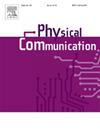Distributed channel selection, relay assignment, and UAV deployment for delay minimization via game framework
IF 2.2
4区 计算机科学
Q3 ENGINEERING, ELECTRICAL & ELECTRONIC
引用次数: 0
Abstract
Due to the flexibility and rapid deployment characteristics, Unmanned Aerial Vehicles (UAVs) are widely used as relays to provide real-time data transmission services. In this paper, the network scenario of relay UAVs (RUs) assisting the communication between mission UAVs (MUs) and the ground base station is investigated. Considering the queuing delay that may be generated by real-time data transmission between UAVs, the total data transmission delay of MUs is minimized by optimizing the channel selection, the relay assignment and the deployment position. In order to solve the problem, the channel selection and deployment position optimization sub-problems are transformed into the potential games. A distributed best-response algorithm and a distributed RU deployment position optimization algorithm based on particle swarm optimization are separately designed to solve the games’ equilibrium. Meanwhile, the relay assignment sub-problem is transformed into a coalition formation game and a distributed relay assignment algorithm is designed based on the switch and swap rules. All algorithms optimize the global network performance based on local information. Simulation results show that the proposed algorithms have better performance than the baseline algorithms and can achieve a low delay in different environments.
通过游戏框架实现延迟最小化的分布式信道选择、中继分配和无人机部署
由于无人机具有灵活性和快速部署的特点,被广泛用作中继器,提供实时数据传输服务。本文研究了中继无人机辅助任务无人机与地面基站通信的组网方案。考虑到无人机之间实时数据传输可能产生的排队延迟,通过优化信道选择、中继分配和部署位置,使无人机的总数据传输延迟最小化。为了解决这一问题,将信道选择和部署位置优化子问题转化为潜在博弈。分别设计了分布式最优响应算法和基于粒子群优化的分布式RU部署位置优化算法来求解博弈均衡。同时,将中继分配子问题转化为联盟形成博弈,设计了一种基于切换和交换规则的分布式中继分配算法。所有算法都是基于局部信息优化全局网络性能。仿真结果表明,该算法比基准算法具有更好的性能,可以在不同环境下实现较低的时延。
本文章由计算机程序翻译,如有差异,请以英文原文为准。
求助全文
约1分钟内获得全文
求助全文
来源期刊

Physical Communication
ENGINEERING, ELECTRICAL & ELECTRONICTELECO-TELECOMMUNICATIONS
CiteScore
5.00
自引率
9.10%
发文量
212
审稿时长
55 days
期刊介绍:
PHYCOM: Physical Communication is an international and archival journal providing complete coverage of all topics of interest to those involved in all aspects of physical layer communications. Theoretical research contributions presenting new techniques, concepts or analyses, applied contributions reporting on experiences and experiments, and tutorials are published.
Topics of interest include but are not limited to:
Physical layer issues of Wireless Local Area Networks, WiMAX, Wireless Mesh Networks, Sensor and Ad Hoc Networks, PCS Systems; Radio access protocols and algorithms for the physical layer; Spread Spectrum Communications; Channel Modeling; Detection and Estimation; Modulation and Coding; Multiplexing and Carrier Techniques; Broadband Wireless Communications; Wireless Personal Communications; Multi-user Detection; Signal Separation and Interference rejection: Multimedia Communications over Wireless; DSP Applications to Wireless Systems; Experimental and Prototype Results; Multiple Access Techniques; Space-time Processing; Synchronization Techniques; Error Control Techniques; Cryptography; Software Radios; Tracking; Resource Allocation and Inference Management; Multi-rate and Multi-carrier Communications; Cross layer Design and Optimization; Propagation and Channel Characterization; OFDM Systems; MIMO Systems; Ultra-Wideband Communications; Cognitive Radio System Architectures; Platforms and Hardware Implementations for the Support of Cognitive, Radio Systems; Cognitive Radio Resource Management and Dynamic Spectrum Sharing.
 求助内容:
求助内容: 应助结果提醒方式:
应助结果提醒方式:


